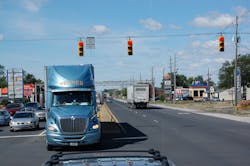Year-end earnings reports from some of the largest carriers in the TL sector indicate that most are successfully finding ways to profit from a sluggish to moderate freight environment, with many expecting further tightening of capacity later this year – in part fostered by a host of regulatory initiatives – to boost their ability to win rate increases.
“The environment in both 2012 and 2011 were similar in terms of growth [with] the economic environment continued in the lukewarm fashion we have become accustomed to,” stated Knight Transportation in its year-end earnings statement, noting that its net income jumped 1.3% to over $17.6 million on 8.1 % higher revenues of over $242.3 million in 2012 vs. 2011.
Werner Enterprises noted that while freight demand in the first three weeks of the fourth quarter last year stayed steady, it did not show typical seasonal improvement and remained consistent with the sluggish freight trend experienced in the latter half of third quarter 2012.
“Freight demand was softer in fourth quarter of 2012 compared to relatively strong demand experienced in fourth quarter of 2011,” the carrier noted. “In fourth quarter of 2012, customers were generally more cautious with their shipping volumes and tightly managed inventories during this period of economic and fiscal policy uncertainty.”
As a result, Werner said its revenues for 2012 stayed flat at a little over $509.6 million, while net income declined 12% to $25.9 million, compared to 2011.
Meanwhile, J.B. Hunt Transportation Services said it experienced a 12% jump in annual revenues to $5.1 billion versus to 2011 – while operating income shot up 19% to $530.2 million and earnings per share jumped 23% to $2.59 per share in year-over-year comparisons – as its efforts to diversify away from traditional TL service continued to pay off.
“Load growth of 11% in intermodal helped drive a 13% increase in segment revenue, while dedicated contract services revenue increased by 9% primarily from the addition of new accounts,” the carrier explained in its earnings report. “Our integrated capacity solutions segment revenue increased by 30% mostly from a 47% increase in load volume, while our truck segment revenue decreased 12% primarily from a 19% reduction in fleet size compared to a year ago.”
Indeed, Werner Enterprises is taking a page from the same “diversification” playbook as it seeks ways to sustain and build revenues with the existing levels of freight volumes.
“We continue to diversify our business model with the goal of achieving a balanced portfolio of revenues comprised of one-way truckload, which includes the short-haul, regional, medium-to-long-haul van and expedited fleets, specialized services and VAS [value added services]” operations, the carrier noted.
Werner also pointed out that its specialized services division, primarily devoted to dedicated operations, ended the fourth quarter last year with 3,295 trucks – or some 46% of its total fleet.
Carriers also expect TL capacity to continue tightening as 2013 progresses, driven mainly by regulatory initiatives such as new hours of service (HOS) rules and the impending imposition of electronic on-board recorders (EOBRs), as well as higher equipment costs.
“Capacity in our industry remains constrained by economic, safety and regulatory factors,” noted Werner in its year-end earnings statement. “The Federal Motor Carrier Safety Administration (FMCSA) published final driver HOS rules in December 2011 to be effective July 1, 2013. Among the changes are more restrictive requirements covering driver use of the 34-hour restart rule and a new mandatory 30-minute rest period after 8 hours on duty. Assuming the rules are adopted without change, we currently believe the new rules will result in a modest decrease in truck productivity.”
Werner added that the price tag for 2010-emission compliant trucks, coupled to their higher operating costs, will also continue to act as a brake on capacity growth.
“Orders for new class 8 trucks slowed during 2012 [and] we believe orders slowed as current freight rate relief is not keeping pace with the increased costs and capital requirements for new and much more expensive EPA-compliant trucks,.” The carrier said. “The significantly higher costs of new equipment and related diesel exhaust fluid will not be recovered through a single year rate review cycle.”
Those are just some of the reasons why Eric Starks, president of research firm FTR Associates, thinks a big crunch in TL capacity should occur by mid-year.
“As we get into the middle of the year, even with just moderate freight demand, we still feel capacity will develop into a major issue,” he told Fleet Owner. “HOS will be coming into play by then and still we feel that will affect capacity.”
For that and other reasons, some carrier executives are now reluctant to project how their companies might perform in the coming year.
"In my opinion, there remains much economic uncertainty,” noted Henry Gerkins, chairman, president and CEO of Landstar System, in the carrier's annual report.
Thus despite posting what he called “very good” full -year operating results for 2012 – over $2.79 billion in annual revenue compared to over $2.64 billion in 2011, with earnings per share jumping to $2.77 versus $2.38 in 2011 and while posting a 4 percentage point jump in its 2012 operating margin to a record 46.2% – Gerkins remained mum on how Landstar might do in 2013 largely because of broader macroeconomic concerns.
“I will not be providing specific ranges of 2013 first quarter and full year revenue and earnings projections at this time,” he said.
About the Author
Sean Kilcarr
Editor in Chief
Sean Kilcarr is a former longtime FleetOwner senior editor who wrote for the publication from 2000 to 2018. He served as editor-in-chief from 2017 to 2018.
